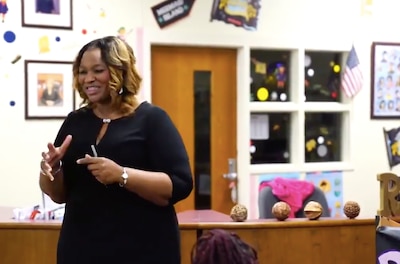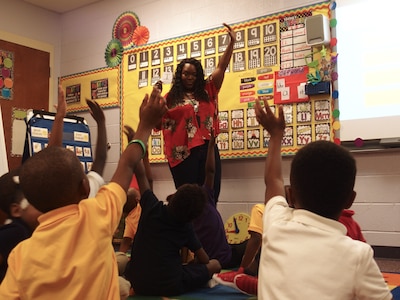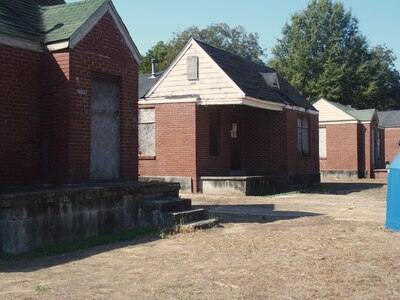At first glance, the three Memphis elementary schools that improved test scores enough to come off the state’s list of lowest performing schools have little in common.
Dunbar Elementary is a small school in Orange Mound, one of the city’s oldest and proudest black neighborhoods. Getwell Elementary is a mid-size school in Parkway Village that has a growing Hispanic population, with many of the parents there having only limited English. Robert R. Church Elementary, by far the largest of the three with 700 students, sits on the edge of Whitehaven, a predominately African-American community which was once a suburb of Memphis 50 years ago.
What binds them, though, is that all three schools have been using lessons from the Innovation Zone, Shelby County Schools’ flagship improvement program — even if they aren’t directly a part of that expensive program.
“There was similar practice for data-driven instruction inside the classroom,” Antonio Burt, the district’s chief academic officer, said of the three schools. “Even though it wasn’t a school in the iZone, the school still implemented some of those same similar strategies.”
Following the iZone’s lead, some of these schools have added instruction time, increased collaboration among teachers and administrators, hired academic coaches, and sought new ways to engage parents with job fairs and meetings on topics such as establishing credit. The schools use the same curriculum that schools across the district do, but leaders say these various strategies make the difference.
Seventeen out of the iZone’s 25 schools that entered the program before this school year have exited the state’s priority list of schools scoring in the bottom 5% on state tests, and results have been similarly positive for other schools that have adopted some of the iZone’s tried-and-true approaches, now in its eighth year. Each iZone school gets an extra $700,000 a year, on average, which researchers say is crucial to maintaining making the program’s gains sustainable.
And even without the extra funding that comes with the iZone participation, the district has been able to funnel more money to struggling schools because of its switch to student-based budgeting, a process that shuffles funds to schools based on student needs, not just the number of students it enrolls. The district’s formula this year prioritizes students living in poverty, elementary schools to boost early literacy, and students who often move from school to school.
Getwell Elementary
At Getwell, improvement efforts focused on the entire family — evidenced by its recent job fair for parents, an idea that came from a suggestion box the principal set up in the front office.
“They’re not just looking at the students, but the parents and the community,” Cecilia Mitchell, who has two grandchildren at the school, said of Getwell’s staff. “It starts with the leader.”

That leader, Tina Smith, started at Getwell in 2018 after two years as assistant principal at Treadwell Middle School, which escaped the state’s priority list in 2014. Getwell was one of seven low-performing schools that year that Shelby County Schools did not place in any sort of school improvement program. (All seven entered the iZone this school year.)
Several months before the 2018-19 school year started, she set up one-on-one meetings with teachers to find out what the school needed. The overwhelming response was more parent involvement, she said.
So Smith hired back a bilingual mentor to help build relationships with Hispanic parents who spoke limited English. She set up a “Popsicles with the Principal” meetings for parents of pre-kindergarten students at the school, whom she learned often feel isolated from the rest of the elementary school community. And when it came time for parent meetings, she sent out robo calls and text reminders, assuring parents there would be dinner to ease the nighttime routine interruption.
She attributes these efforts to a jump in enrollment — in one year, the school had 100 additional students, including an additional pre-K class. “OK, now I got the kids here, I got the parents here. Now let’s get to the instruction,” Smith said.
Smith and her team visited several higher-performing schools in the area to observe how they conducted staff meetings and lesson planning — collaboration that is key in the iZone. To start, she picked out one or two things to implement so as not to “overwhelm the staff,” she said.
Getwell leaders then started modeling lessons for teachers at weekly meetings and giving them time to provide feedback to their peers, also a tenet of the iZone.
“That was important because the teachers were like, ‘Wow, you know what we’re teaching. You know what lesson we’re supposed to be on,’” Smith said. “So, I think that gave me a little buy-in with them to really, really trust the process of what we needed to do.”
Getwell, which entered the iZone this year, is still well behind the district average in both English and math, but improved enough to escape possible state takeover. About 19% of students meet state requirements in math, while about 12% are proficient in English.
Districtwide, about 21% of elementary students are proficient in English, while 27% of elementary students meet the same standard in math.
Robert R. Church Elementary
Change at Robert R. Church Elementary came so fast that Shelby County Schools promoted Principal Janice Tankston to coach other principals after just one year. Tankson had just spent 10 years leading Levi Elementary where nearly half of students are proficient in math — about twice the district average. At Robert R. Church, she was the third principal in five years and staff were aching for a breakthrough.

“When you’re at the bottom you have to think outside of the box,” Tankson said.
That year, under her leadership, the school entered the Whitehaven Empowerment Zone, which was introduced in 2016 as a smaller, neighborhood-focused version of the iZone to prevent low-performing schools from showing up on the state’s priority list. Each school receives about $325,000 — or about half of what iZone schools receive. Tankson used those funds to hire an additional school counselor, family engagement specialist, assistant principal, and small group instructor.
“We really had a large amount of people to support our students,” she said.
Tankson also built an entirely new administration team and only kept one out of every three teachers, a strategy borrowed from the iZone. One of her assistant principals came from Nashville, while another came from Detroit. The teachers she hired had evaluation scores rated 3 or higher on the state’s 5-point scale, which is a Empowerment Zone requirement.
Every certified staff member had a group of students to tutor before or after school, including Tankson. The sessions, with up to seven students, lasted 45 minutes, four days a week, from February until the first day of state testing in April.

Robert R. Church’s test scores in both English Language Arts and math now exceed the district average, after lagging behind in recent years. In 2018, just 9% of students were proficient in English. Last year, it was about 24%. In math, the share of students scoring proficient increased from 16% to 37%.
Now, the new principal, Marqui Fifer, looks to maintain the school’s momentum. He noted the collaboration between schools in the neighborhood is key to the Empowerment Zone’s success, a strategy adapted for the neighborhood from the iZone. Before starting at Robert R. Church, Fifer was the principal at Colonial Middle, a popular fine arts school in a wealthier neighborhood, near the University of Memphis.
“We actually collaborate. We talk about trends. We talk instruction-wise about things students need to know here so we’re planning with the end in mind,” Fifer said. “This is strategically done so that everybody in this community is doing and seeing the same things.”
Dunbar Elementary
At Dunbar Elementary, change was more of a slow burn. Principal Anniece Gentry came to the Orange Mound school in 2013 to a chorus of parents and students concerned about bullying, which “overshadowed” academics, she said.
“I had to meet with students to assure them that this place is a safe place and that your issues will not go unaddressed,” Gentry said. Sometimes that meant Gentry and teachers would walk students home and talk to parents about their concerns. The school counselor focused on school-wide culture and building positive relationships.

But feelings of “family” at the school were hard to reach, she acknowledged. The school’s parent-teacher organization had fits and starts despite holding sessions on topics, from navigating the city’s utility company to establishing credit.
That all changed when then-Superintendent Dorsey Hopson briefly considered closing Dunbar during the 2016-17 school year and community members came out in force. Hopson later rescinded his closure recommendation and instead created a new school improvement program called “critical focus” that would pump $300,000 into Dunbar’s budget and that of 10 other schools.
From the archives: How one Memphis school in the ‘critical focus’ program put its extra cash to work
“That was such an eye-opener to me as a leader because of the fact I saw for myself that the community believed in our scholars,” Gentry said. “That was a turning point for me.”

Joyce Dorse-Coleman, whose seven children and five of her grandchildren have attended Dunbar, was the president of the school’s PTO at the time and helped organize pushback against closing the school.
“After all this, the parents knew that if we don’t continue to improve our test scores and we don’t continue to be involved, talk about closing the school could come back,” Dorse-Coleman said, who went on to run successfully for school board in 2018. “And we don’t want to go through that every three or four years.”
Gentry said from then on, students wanted to “prove everybody wrong,” about the school’s lagging academic performance.
“Students began to ask teachers, ‘What did I make on my test?’ or ‘Dr. Gentry! Do you know how I did?’ Their focus was on the academics. It shifted,” she said, noting all teachers stayed on the next year after the closure threat to carry out the improvement plan.
The $300,000 afforded the school reading and math teacher coaches that spent all their time at Dunbar rather than split between several schools, which is common in iZone schools. Teachers were paid for one hour of after-school tutoring and some Saturdays.
Dunbar students now score better in math than the district’s average — which saw a significant jump last year — and are gaining ground in English.
“And one thing I think helped us: We were not afraid to let the parents know the status of the school. No matter how good or how bad the data was,” Gentry said.

Now, the school’s new principal, Brian Ingram, is rebuilding trust with parents after an almost complete staff turnover because Dunbar was one of 11 schools to enter the iZone this year. One of the requirements of the iZone is to replace the principal if they have been there for more than three years and that all staff must reapply for their jobs. The school still has a long way to go — just 13% of students meet state requirements in English.
Ingram hosted several introductory events for parents and Orange Mound community leaders to get to know him and the new staff, including a block party with giveaways, and has been making his rounds at neighborhood meetings. Ingram also spruced up the front lobby and regularly plays music as students enter school in the morning as a way to counter the view of houses falling apart directly across from the school.
“I want them to forget about what they just saw and know that they’re in a safe space and that they can do anything when they come in here,” he said.

